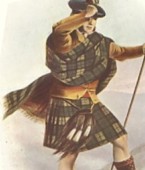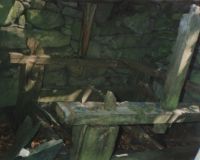
HOME TARTAN HISTORY KILT HISTORY WEARING KILT GALLAECIA
 |
This page is about Tartan, a pattern consisting of criss-crossed horizonal and vertical bands in multiple colours. For information about the kilt, please visit History of the Kilt.
This page contains the following sections:
+ What is a Tartan?
+ Tartan as a European textile design
+ Tartan as a means of territorial identification
+ Fall and rise of tartan fashion in Atlantic Europe
+ A brief history of tartan in Galicia
What is a Tartan?
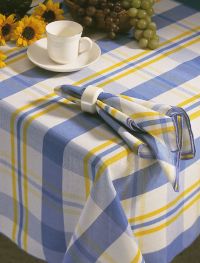 Tartan is used on many materials and can be found anywhere at home, for example as a table cloth. [Enlarge image]  Traditional tartan loom. [Enlarge image] |
Traditionally, tartan was woven by hand in four shaft looms using coloured woollen yarns. The weaver used alternating bands of threads woven as both warp and weft at right angles to each other. That formed regular blocks of colours repeated vertically and horizontally in a distinctive pattern of squares and lines.
Tartan originated in woven cloth, but is now used in many other materials. If you pay close attention, you may find tartans anywhere at home: in your wardrobe (scarves, pullovers, skirts), in your kitchen (table cloths), in your bedroom (pajamas, blankets), etc.
Although tartan is most commonly associated with Scotland, it is actually an ancient textile design which has been known all across western and central Europe for thousands of years.
As any other woven cloth, tartan could be used on any garment. The Kilt, a type of masculine skirt, is probably the best known tartan garment. Again, kilt is renowned internationally as Scotland's national dress. However, male skirts were common fashion in Atlantic Europe until the introduction of the trousers in the 16th century.
Tartan as a European textile design
Tartan has been an essential part of the Scottish national dress since the 18th century and therefore most people believe that tartan was originally created in Scotland.
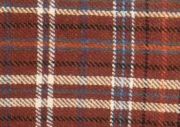 Tartan
worn by the indoeuropean mummies found in Ürümchi. Tartan
worn by the indoeuropean mummies found in Ürümchi.[Enlarge image] 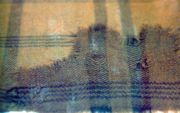 Tartan found in the salt mines of Hallstatt, Austria. [Enlarge image] 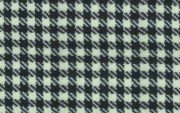 Northumbrian tartan, an example of a primitive tartan. The light stripes are made of white wool and the dark stripes are made with black wool. [Enlarge image]  Statue of Galician king found at San Julião Celtic Hillfort, 3rd century BC. Picture by André Pena. [Enlarge image] |
The oldest tartan ever found was worn by the Ürümchi mummies around 1500 BC. The Ürümchi mummies belong to a group of caucasian indoeuropeans who explored the Silk Route between Europe and Central Asia. The mummies were found in the Xinjiang region, western China, dressed with colourful tartan plaids.
Further archaeological discoveries of early tartans have been found in the Alps, Great Britain and Galicia.
Tartan cloth was found in the ancient salt mines at Hallstatt, in the Austrian Alps, and it is believed to have been woven about 1,200 BC. A local textile company used the finding to increase their sales claiming that tartan was originally created in Austria.
The two oldest examples of tartan in Atlantic Europe date both from the 3rd century BC and were found in Scotland (the Falkirk Sett) and in Galicia (statues of Celtic chieftains).
The Falkirk Sett is a piece of woolen cloth which was found buried in the Antonine Wall, near the town of Falkirk in Scotland. The cloth is kept at the National Museum of Scotland and is the oldest tartan found in the British isles.
Also dated from the 3rd century BC, archaeologists have found several statues of Galician kings wearing male skirts or primitive kilts, with those kilts showing clearly a tartan pattern consisting of criss-crossed horizontal and vertical bands.
There are later examples of tartan cloth found also in other places in Europe from Scandinavia to France.
The origin of the word "tartan" is not clearly known. Many believe that "tartan" comes from the mediaeval French word Tiretaine, which meant a piece of cloth made in wool and linen. Some others believe that the word "tartan" comes from the gaelic Tuar and Tan, which mean "colour" and "county" respectively.
Tartan as a means of territorial identification
Tartan only started to be used as a means of Scottish clan identification during the 19th century, but historians believe that in ancient times people could tell what area of Scotland someone was from by the shade of the dyes that were used in their clothing.
Natural dyes were produced from lichen, bark, or berries of plants and trees. Because the weavers were restricted to the colours they could produce from the local vegetation, tartans produced in the area were frequently made in the same colours and frequently even in the same pattern.
In the 18th century, a Scottish writer called Martin Martin wrote in his Description of the Western Isles of Scotland that "Every isle differs from each other in their fancy of making plaids as to the stripes in breadth and colours. This humour is as different through the mainland of the Highlands, in so far that they who have seen those places are able at first view of a man’s plaid to guess the place of his residence."
Similarly, when in the late 18th century Sir Alan Cameron of Erracht founded the Cameron Highlanders regiment, he designed a red tartan for it on the basis that the traditional tartan worn in the Lochaber region was red in colour.
During the 19th century, tartan became widespread in Scotland as a means of Scottish clan identification. Some authors maintain that -like Sir Alan Cameron- many clan chiefs might have originally adopted their tartan based on the shade of dyes that were most commonly used in their district.
Fall and rise of tartan fashion in Atlantic Europe
Tartan was a widespread textile design in Celtic Europe during the Iron Age. In the same way that we buy today branded clothing to show our lifestyle, it is believed that tartan was also used in ancient times to show the social standing of a person within a group. A local king or chieftain would have the means for purchasing a colourful, quality woven tartan, while the common peasant would not be able to afford such a garment.
As the Roman Empire expanded across Europe, Mediterranean fashions were introduced and the Celtic aristocracy started to look for the latest fashion from Rome. New times bring new fashions and the plain greco-latin tunic became the new dress code among the beautiful people in Celtic Europe. And so, the colourful tartan slowly became "out of fashion".
Greco-latin fashion lasted up to the Middle Ages as the mainstream dress code among the upper classes in Western Europe. The Middle Ages were in turn followed by a new era of colonial expansion and intensification of trade with Asia. New fabrics and new fashions were introduced in Western Europe. The upper classes had by now a much wider choice of exotic and expensive fabrics to dress with. The old woolen tartan was still seen as a rustic garment only worn by those who could not afford the latest European fashions.
 Battle of Culloden, painted by David Morier, ca.1750. The British troops appear dressed in the latest military fashion of the 18th century, while the Highlander Scots are shown wearing the rustic tartan outfit. [Enlarge image] |
The prohibition of wearing tartan lasted for 36 years until it was abolished in 1782. Inevitably, the ban backfired and tartan was immediately promoted as Scotland's national dress.
Tartan and kilt were adopted as the uniform of the Scottish regiments at the end of the 18th century. Over the following decades, Scottish clan chieftains started to create their very own clan tartans. In 1831 was published "The Scottish Gael", the first comprehensive compilation of Scottish clan tartans. Tartan was definitely back in fashion and was even dressed by the British royals during their visits to Scotland.
Ever since then, tartan has been an essential part of the Scottish national dress and has been most commonly associated with all things Scottish.
The 20th century saw a revival for all things Celtic and subsequently tartan was also reintroduced to a lesser degree in the other Celtic nations.
A brief history of tartan in Galicia
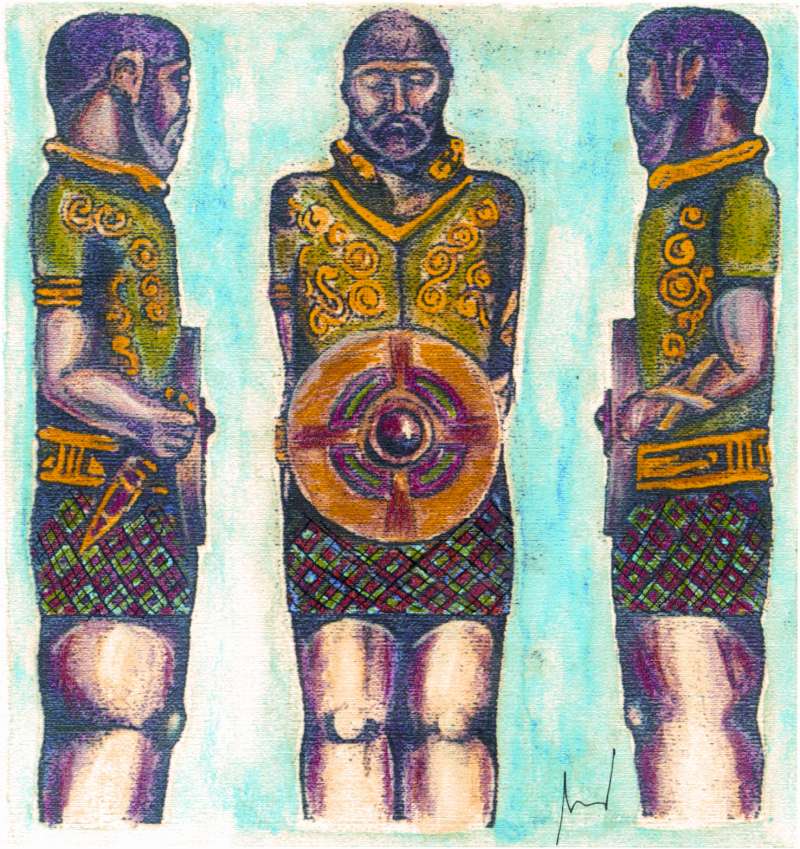
Statue of Galician king or "Princeps" dated ca.400
BC and found at Lezenho Hillfort, southern Gallaecia.
Colour print by André Pena
[Enlarge image]
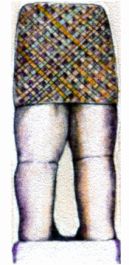 Statue of a Galician king or 'princeps' found at Mozinho Hillfort, dated ca.400 BC. Colour print by André Pena. [Enlarge image] |
Galicia
lies to the southwest of continental Europe, to the south of
the Celtic Sea. This ancient kingdom is a land of mountains,
green forest and deep river valleys, fringed by spectacular
coastlines. The landscape is littered with historic sites -
stone age burial chambers, iron age settlements, and
mediaeval castles. History and legend are inextricably
intertwined.
As in many other parts of Atlantic and Central Europe, the
ancient Galicians also wore tartan. We know that as a fact,
for here were found the oldest statues in Atlantic Europe
showing men dressed in rudimentary tartan kilts.
Dated ca.400 BC, just around the same period than the
Falkirk Sett in Scotland, giant statues were carved in
southern Gallaecia (the ancient name of modern Galicia) to
honour regional or perhaps high kings of the country.
Those Galician kings are portrayed in a military fashion, in
the same way that many mediaeval kings and earls were also
solemnly represented wearing their sword and shield.
But the striking thing about those statues is the way they
are dressed. Those men are wearing kilts, over which
distinctive patterns of squares and lines are carved as to
represent a primitive tartan like the Falkirk Sett or the
Northumbrian tartan.
 Remains
of ancient looms dated around the same period than the royal
statues have been found all across Galicia, meaning that
tartan was worn in other parts of the country. In Santa
Tegra Iron Age Hillfort, not far away from where the King
of Lezenho was found, archaeologists found 47 loom
weights - all similar to other loom weights found in the
rest of Celtic Europe where tartan was also manufactured.
Remains
of ancient looms dated around the same period than the royal
statues have been found all across Galicia, meaning that
tartan was worn in other parts of the country. In Santa
Tegra Iron Age Hillfort, not far away from where the King
of Lezenho was found, archaeologists found 47 loom
weights - all similar to other loom weights found in the
rest of Celtic Europe where tartan was also manufactured.
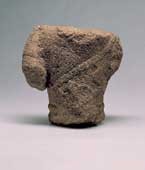 Calaecian plaid: 1st century AD statue of a Celtic Galician chieftain wearing a tartan plaid, found at Santa Ádega Hillfort, Co. Ourense. [Enlarge image] |
Tartan fashion in Gallaecia eventually changed as new fashions came and went in the rest of Europe. During the times of the Roman Empire the colourful tartan simply became "out of fashion" as the Celtic aristocracy rushed to adopt the latest trends from the Mediterranean.
For many centuries, the tartan was relegated to rural parts of the country. It could be found on blankets or cloaks, and was worn only by those who had bigger worries than following the latest fashion of the cities. Tartan textiles were woven by women at home and any surplus could always be sold at county fairs for extra income.
Traditional Galician home weaving almost disappeared during the 20th century as rural Galicia became depopulated, the old weavers died, and no young people were interested in learning how to weave.
In the past years there has been a certain renaissance in Galicia for the old crafts and trades, and traditional home weaving has emerged mainly as a luxury souvenir industry. As the old Galician looms started working again, tartan came back on to blankets, cloaks and kilts, and is increasingly seen as a part of a Galician textile heritage that has been around for over the past two thousand years.
* * * * * *
HOME
TARTAN
HISTORY KILT
HISTORY WEARING
KILT GALLAECIA
